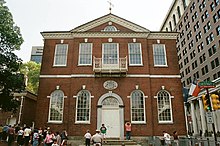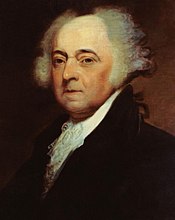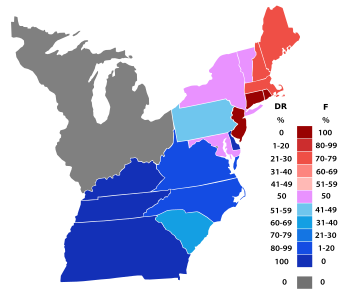| 4th United States Congress | |
|---|---|
| 3rd ←→ 5th | |
 Congress Hall (2007) Congress Hall (2007) | |
March 4, 1795 – March 3, 1797 | |
| Members | 30–32 senators 105–106 representatives 1 non-voting delegates |
| Senate majority | Federalist |
| Senate President | John Adams (F) |
| House majority | Democratic-Republican |
| House Speaker | Jonathan Dayton (F) |
| Sessions | |
| Special: June 8, 1795 – June 26, 1795 1st: December 7, 1795 – June 1, 1796 2nd: December 5, 1796 – March 3, 1797 | |
The 4th United States Congress was a meeting of the legislative branch of the United States federal government, consisting of the United States Senate and the United States House of Representatives. It met at Congress Hall in Philadelphia, Pennsylvania, from March 4, 1795, to March 4, 1797, during the last two years of George Washington's presidency. The apportionment of seats in the House of Representatives was based on the 1790 United States census. The Senate had a Federalist majority, and the House had a Democratic-Republican majority.
Major events
- September 17, 1796: Washington's Farewell Address warned against partisan politics and foreign entanglements.
- November 4 - December 7, 1796: 1796 United States presidential election: Incumbent vice president John Adams defeated Secretary of State Thomas Jefferson.
Major legislation
See also: List of United States federal legislation, 1789–1901Treaties ratified
- June 24, 1795: Treaty of London ("Jay's Treaty")
- March 7, 1796: Treaty of Madrid ("Pinckney's Treaty")
States admitted
- June 1, 1796: Tennessee admitted as a state; formerly the Territory South of the River Ohio, Sess. 1, ch. 47, 1 Stat. 1 - 491 491
Party summary


This was the first Congress to have organized political parties. Details on changes are shown below in the "Changes in membership" section.
Senate
| Party (shading shows control) |
Total | Vacant | ||
|---|---|---|---|---|
| Democratic- Republican (DR) |
Federalist (F) | |||
| End of previous congress | 13 | 17 | 30 | 0 |
| Begin | 10 | 20 | 30 | 0 |
| End | 11 | 21 | 32 | |
| Final voting share | 34.4% | 65.6% | ||
| Beginning of next congress | 9 | 22 | 31 | 1 |
House of Representatives
| Party (shading shows control) |
Total | Vacant | ||
|---|---|---|---|---|
| Democratic- Republican (DR) |
Federalist (F) | |||
| End of previous congress | 54 | 49 | 103 | 2 |
| Begin | 58 | 46 | 104 | 1 |
| End | 59 | 47 | 106 | 0 |
| Final voting share | 55.7% | 44.3% | ||
| Beginning of next congress | 57 | 49 | 106 | 0 |
Leadership

Jonathan Dayton
Senate
- President: John Adams (F)
- President pro tempore:
- Henry Tazewell (F), first elected December 7, 1795
- Samuel Livermore (F), first elected May 6, 1796
- William Bingham (F), first elected February 16, 1797
House of Representatives
- Speaker: Jonathan Dayton (F)
Members
This list is arranged by chamber, then by state. Senators are listed by class, and representatives are listed by district.
Senate
Senators were elected by the state legislatures every two years, with one-third beginning new six-year terms with each Congress. Preceding the names in the list below are Senate class numbers, which indicate the cycle of their election. In this Congress, Class 1 meant their term ended with this Congress, requiring re-election in 1796; Class 2 meant their term began in the last Congress, requiring re-election in 1798; and Class 3 meant their term began in this Congress, requiring re-election in 1800.
Connecticut
Delaware
Georgia
Kentucky
Maryland
Massachusetts
New Hampshire
|
New Jersey
New York
North Carolina
Pennsylvania
Rhode Island
South Carolina
Tennessee
Vermont
Virginia
|
 |

|
House of Representatives
Changes in membership
The count below reflects changes from the beginning of this Congress
Senate
There were 10 resignations, 2 new seats, and 1 election to replace an appointee. There was a 1-seat gain for both the Federalists and the Democratic-Republicans.
See also: List of special elections to the United States Senate| State (class) |
Vacated by | Reason for change | Successor | Date of successor's formal installation |
|---|---|---|---|---|
| Georgia (2) |
James Jackson (DR) | Resigned sometime in 1795 | George Walton (F) | Appointed November 16, 1795 |
| Georgia (2) |
George Walton (F) | Interim appointment expired February 20, 1796, with an election | Josiah Tattnall (DR) | Elected February 20, 1796 |
| Connecticut (1) |
Oliver Ellsworth (F) | Resigned March 8, 1796 | James Hillhouse (F) | Elected March 12, 1796 |
| New York (2) |
Rufus King (F) | Resigned May 23, 1796, having been appointed Minister to England | John Laurance (F) | Elected November 9, 1796 |
| Massachusetts (2) |
Caleb Strong (F) | Resigned June 1, 1796 | Theodore Sedgwick (F) | Elected June 11, 1796 |
| Massachusetts (1) |
George Cabot (F) | Resigned June 9, 1796 | Benjamin Goodhue (F) | Elected June 11, 1796 |
| Connecticut (3) |
Jonathan Trumbull Jr. (F) | Resigned June 10, 1796 | Uriah Tracy (F) | Elected October 13, 1796 |
| Tennessee (1) |
New seat | Tennessee was admitted to the Union | William Cocke (DR) | Elected August 2, 1796 |
| Tennessee (2) |
William Blount (DR) | |||
| Vermont (1) |
Moses Robinson (DR) | Resigned October 15, 1796 | Isaac Tichenor (F) | Elected October 18, 1796 |
| Maryland (1) |
Richard Potts (F) | Resigned October 24, 1796 | John E. Howard (F) | Elected November 30, 1796 |
| South Carolina (2) |
Pierce Butler (DR) | Resigned October 25, 1796 | John Hunter (DR) | Elected December 8, 1796 |
| New Jersey (2) |
Frederick Frelinghuysen (F) | Resigned November 12, 1796 | Richard Stockton (F) | Elected November 12, 1796 |
House of Representatives
There were 9 resignations, 1 death of a Representative-elect, and 1 new seat. There was a 1-seat gain for both the Federalists and the Democratic-Republicans.
Main article: List of special elections to the United States House of Representatives| District | Vacated by | Reason for change | Successor | Date of successor's formal installation |
|---|---|---|---|---|
| Pennsylvania 4 | Vacant | Election was contested and then the apparent winner, James Morris, died July 10, 1795. The House then declared the seat won by the challenger. |
John Richards (DR) | Seated January 18, 1796 |
| Maryland 3 | Jeremiah Crabb (F) | Resigned sometime in 1796. | William Craik (F) | Seated December 5, 1796 |
| Rhode Island at-large | Benjamin Bourne (F) | Resigned sometime in 1796. | Elisha Potter (F) | Seated December 19, 1796 |
| Massachusetts 1 | Theodore Sedgwick (F) | Resigned sometime in June, 1796, having been elected U.S. Senator. | Thomson Skinner (DR) | Seated January 27, 1797 |
| Maryland 2 | Gabriel Duvall (DR) | Resigned March 28, 1796, having been elected judge of the Supreme Court of Maryland. | Richard Sprigg Jr. (DR) | Seated May 5, 1796 |
| North Carolina 4 | Absalom Tatom (DR) | Resigned June 1, 1796. | William Strudwick (F) | Seated December 13, 1796 |
| Massachusetts 10 | Benjamin Goodhue (F) | Resigned sometime in June 1796, having been elected U.S. Senator. | Samuel Sewall (F) | Seated December 7, 1796 |
| Connecticut at-large | James Hillhouse (F) | Resigned July 1, 1796, having been elected U.S. Senator. | James Davenport (F) | Seated December 5, 1796 |
| Territory South of the River Ohio | James White | Served until June 1, 1796, when Tennessee was admitted to the Union. | District eliminated | |
| Tennessee at-large | New seat | Tennessee was admitted to the Union June 1, 1796. Seat remained vacant until December 5, 1796. | Andrew Jackson (DR) | Seated December 5, 1796 |
| Pennsylvania 5 | Daniel Hiester (DR) | Resigned July 1, 1796. | George Ege (F) | Seated December 8, 1796 |
| Connecticut at-large | Uriah Tracy (F) | Resigned October 13, 1796, having been elected U.S. Senator. | Samuel Dana (F) | Seated January 3, 1797 |
Committees
Lists of committees and their party leaders.
Senate
House of Representatives
- Claims (Chairman: Uriah Tracy then Dwight Foster)
- Commerce and Manufactures (Chairman: Benjamin Goodhue then John Swanwick)
- Elections (Chairman: Abraham B. Venable)
- Revisal and Unfinished Business (Chairman: Nicholas Gilman)
- Rules (Select)
- Ways and Means (Chairman: William Loughton Smith)
- Whole
Joint committees
- Enrolled Bills (Chairman: N/A then Richard Stockton)
Officers
Senate
House of Representatives
- Chaplain: Ashbel Green, Presbyterian
- Clerk: John Beckley
- Doorkeeper: Thomas Claxton
- Reading Clerks: [data missing]
- Sergeant at Arms: Joseph Wheaton
See also
- 1794 United States elections (elections leading to this Congress)
- 1796 United States elections (elections during this Congress, leading to the next Congress)
Notes
- Special session of the Senate.
- Anti-Administration
- Pro-Administration
- Anti-Administration
- Pro-Administration
- ^ When seated or oath administered, not necessarily when service began.
References
- Martis, Kenneth C. (1989). The Historical Atlas of Political Parties in the United States Congress. New York: Macmillan Publishing Company.
- Martis, Kenneth C. (1982). The Historical Atlas of United States Congressional Districts. New York: Macmillan Publishing Company.
External links
- Statutes at Large, 1789-1875
- Senate Journal, First Forty-three Sessions of Congress
- House Journal, First Forty-three Sessions of Congress
- Biographical Directory of the U.S. Congress
- U.S. House of Representatives: House History
- U.S. Senate: Statistics and Lists
| United States congresses (and year convened) | ||||||||||||||
|---|---|---|---|---|---|---|---|---|---|---|---|---|---|---|
